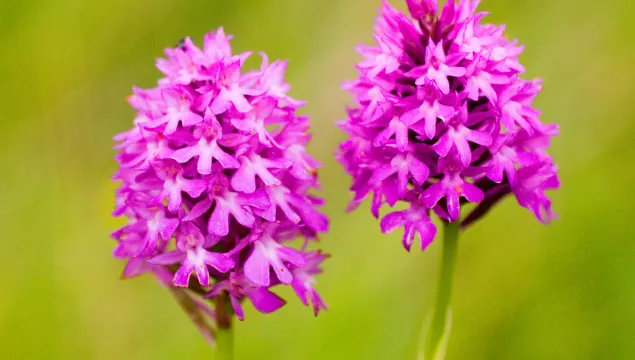Chiltern gentian
Considered to be one of the prettiest gentians, the Chiltern gentian is a rare plant in the UK. It likes chalk grasslands, its purple, trumpet-shaped flowers blooming from August.
Considered to be one of the prettiest gentians, the Chiltern gentian is a rare plant in the UK. It likes chalk grasslands, its purple, trumpet-shaped flowers blooming from August.

The Pyramidal orchid lives up to its name - look for a bright pinky-purple, densely packed pyramid of flowers atop a green stem. It likes chalk grassland, sand dunes, roadside verges and quarries.
Horseshoe vetch is a member of the pea family, so displays bright yellow, pea-like flowers and seed pods. Look for this low-growing plant on chalk grasslands from May to July.
Living up to its name, the hairy violet is covered in fine hairs. Look for its delicate, violet flowers blooming from March to June on chalk grasslands, in particular.
As its name suggests, the Dwarf thistle is a low-growing plant that is almost stemless - its purple, thistle-like flower heads growing out of a rosette of spiny leaves.
The aromatic fragrance of Large thyme can punctuate a summer walk over a chalk grassland. It is an evergreen that grows low to the ground, with erect spikes of tiny, lilac flowers appearing over summer.
Windy, open moors covered in bright yellow, spiky common gorse bushes and purple heathers are synonymous with what we call 'wild' landscapes, but it can be seen in many habitats, from coast to town.
Broom is a large shrub of heaths, open woodlands and coastal habitats. Like gorse, it has bright yellow flowers, but it doesn't have any spines and smells of vanilla.
Look for the pinky-white flowers of the dog-rose in summer, and its bright red rosehips in autumn. It is a scrambling shrub of hedgerows, woodlands and grasslands.
Sea-buckthorn is a spiny, thicket-forming shrub of sand dunes. It's native to the east coast of England but considered an invasive species elsewhere. It is most obvious in autumn when it is full of bright orange berries.
Buddleia is a familiar shrub, well-known for its attractiveness to butterflies. It is actually an introduced species, however, that has become naturalised on waste ground, railway cuttings and in towns.
Wild privet is a shrub of hedgerows, woodlands and scrub, but is also a popular garden-hedge plant. It has white flowers in summer and matt-black berries in winter that are very poisonous.